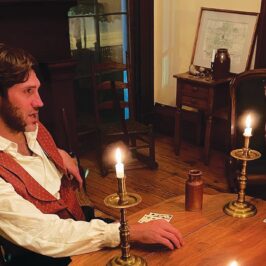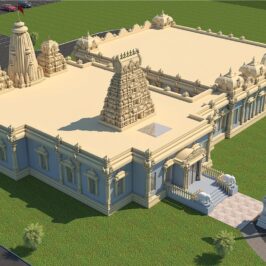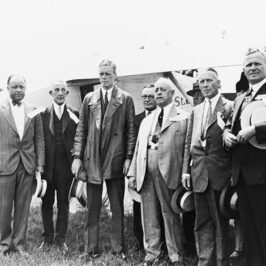The origins of Springfield school names
By Cinda Ackerman Klickna
It’s easy to figure out how some schools got their names: Fairview had a view of the fair; Pleasant Hill stood on a pleasing hillside; Southern View, Laketown, and Southeast referred to specific areas of the city.
A grove of hazelnut trees led to the naming of Hazel Dell School, and Harvard University lent its prestige to Harvard Park. In keeping with the education theme, as the surrounding park-like area developed, streets were given names of other prominent colleges, such as Yale.
Presidents Washington, Jefferson, and Grant have had schools named after them across the country. Yet here you’ll also find schools named after a Native American (Black Hawk), a poet (Carl Sandburg), and a social activist (Jane Addams). But our schools draw most of their names from a long list of prominent, influential Springfield leaders.
Our city’s first school opened in 1821. Teacher Andrew Orr stood with rod at his side as he taught 40 to 60 students, who sat on benches in a log building. In 1828 a log schoolhouse went up at Adams and Second, and students were charged $1.50 to $3 per term. Soon several more private schools sprang up–the Springfield Academy (1839), Female Academy (1849), and Concordia College (1852).
The public school system started in 1854. The first classrooms were open only to white children. It wasn’t until 1874 that black students were allowed to attend public schools. From 1858 to 1874, the African school operated on the east side of Fourth Street between Madison and Capitol.
At first four schools were built in the four wards of the city. These schools were merely known by their numbers. Later, though, they were given names–Palmer in the First Ward, Trapp (now known as Douglas) in the Second Ward, Edwards in the Third, and Lincoln in the Fourth. By 1858, 22 teachers were employed in Springfield. Today that number is close to 1,100.
Palmer was named for John McAuley Palmer, Illinois Governor from 1869 to 1873; Lincoln, of course, was our most famous Springfieldian; Edwards came from Lincoln’s in-laws; and Trapp was named for a man with an interesting past.
Albert Trapp had attended the University of Heidelberg in Germany, where he was imprisoned for one year for opposing the emperor. Upon his release, he went to Switzerland and studied medicine at the University of Zurich, where he got into a duel with a student from another university. That student’s second was von Bismarck, founder of the German Empire. We don’t know what happened in that duel, but Trapp obviously survived, for he moved to the United States, settled in Belleville, and became a doctor. He was elected as a Democratic state representative in 1854. When one of his patients, William Bissell, became Governor in 1857, he convinced Trapp to move to Springfield. Trapp died here at the age of 88 in 1891.
The school was later renamed Douglas, but then it got changed back to Trapp in 1887. In 1913 it returned to Douglas.
Moving in alphabetical order, let’s take a look at the prominent Springfield citizens who have been remembered through the names of our schools:
Enos
Father and son, Pascal and Zimiri, were both well-known citizens. Pascal was one of the founding fathers of Springfield. He, along with Elijah Iles in 1823, purchased land for a town to be called Calhoun, but the name was obviously never used. Zimiri, an alderman, school board member, city engineer (in the 1870s he developed the Enos Flats apartments on Fifth Street), and attorney, donated land for Enos School in his father’s name. When the school was finally built, it recognized both him and his father.
Feitshans
Now called Feitshans-Edison, this school has been an elementary, middle, and high school since it was built in 1886. Professor F.R. Feitshans had served as the Superintendent of Schools, and in 1886, while attending a National Teachers Association meeting in Denver, died of typhoid.
Graham
Elizabeth Graham taught English for 42 years at Springfield High School, serving as the chair of the English department for 21 years. She worked diligently to establish the Vachel Lindsay Association and became the curator of the Vachel Lindsay Home. She died at the age of 90 in 1982.
Iles
Most every schoolchild knows that Elijah Iles (1796-1883) was Springfield’s first storekeeper.
Lanphier
Robert C. Lanphier was the founder and president of Sangamo Electric, which began operation here in 1899. His father, Charles H. Lanphier, had been an advisor to Stephen A. Douglas and helped to draft the legislation that started the Springfield Public Schools.
Lawrence
Rheuna Lawrence, father of Susan Lawrence Dana, served as mayor of Springfield from 1891 to 1892 and was a member of the school board.
Lee
Edwin A. Lee, who died in 1993, was a well-respected doctor who also served on the school board.
Lindsay
Springfield’s great poet, Vachel Lindsay (1879-1931) has had two schools named after him: one on Chatham Road (now housing the district’s Instructional Resource Center and a city police station) and the recently built school at 3600 Fielding Dr.
Marsh
Owen Marsh (1908-1964) served on the school board for 14 years. He died while attending a 1964 Illinois Education Association meeting in Chicago.
Matheny
James H. Matheny (1818-1890) was a Sangamon County judge, a circuit clerk, and a lieutenant colonel in the Civil War. A friend of Abraham Lincoln, he served as best man at Lincoln’s wedding. When Matheny died, his funeral was the largest Springfield had ever seen outside of Lincoln’s. Originally the school was called Brainerd. His father, Charles R. Matheny, owned Matheny and Company Dry Goods. Later, a clerk in that store, John Bressmer, bought out his boss and opened Bressmer’s, which became a well-known department store that operated in downtown Springfield for many years.
McClernand
John Alexander McClernand was the co-publisher of the state’s first Democratic newspaper, located in Shawneetown. He moved to Jacksonville and became a state legislator from 1836 to 1838 and again from 1840 to 1842. He fought at the Battle of Shiloh, led an expedition in 1863 to capture an Arkansas post, participated in the Battle of Vicksburg, presided at the 1876 Democratic Convention in St. Louis, and was appointed by President Grover Cleveland to the Utah commission in 1885. He died on September 20, 1900, at the age of 88.
There have been two schools named after McClernand, located a few blocks from each other. The first had been built in 1882 on the site of the McClernand family home. When it had to be demolished in 1937, another school was built at its present location, 801 N. Sixth.
Ridgely
Nicholas H. Ridgely (1800-1888) operated the Ridgely Bank at Fifth and Monroe. The first site of the school stood at a spot now known as Sangamon Avenue, with the address 1013 Fair Grounds. In 1900 it was rebuilt at its present site on N. Eighth.
Wanless
Charles S. (1884-1945) and Fred W. Wanless (1881-1949) were popular realtors and developers. They donated land for a new school on Reservoir Street, now called Wanless.
Wilcox
Susan Wilcox (1867-1943) started teaching English at Springfield High School in 1888 and stayed on for an incredible 46 years. One of her students was Vachel Lindsay, who wrote in the preface to his Collected Poems that she was “the noblest and most faithful friend of my life.” She organized the Springfield American Association of University Women.
Withrow
Wesley O. Withrow (1876-1957) had a long career in education. Beginning his teaching in a rural school at $35 a month, he later became the principal of Feitshans, earning $1,100 a year. On his first day as principal, he got off the streetcar at 11th and Kansas and was attacked by a dog that ripped his pants; the owner quickly sewed his trousers so he could proceed to work. When fire destroyed Feitshans School in 1920, he became principal of Lincoln School and then went on to become the county Superintendent of Schools in 1938. When Withrow School was dedicated in 1952, he attended the ceremony, held on a snowy day in April.
Gone and now forgotten
Former schools named after important Springfieldians:
Bunn
Bunn School stood at 12th and Division from 1900-1973 and was razed in 1974. Jacob Bunn (1814-1897) founded the Illinois Watch Factory, owned Bunn Capitol Grocery Company, and started Marine Bank (now Bank One).
Converse
Built in 1862 and named after Henry Converse (1807-1889), the farmer who donated the land for the building. Converse School closed in 1939. In 1940 it became the Cathedral Boys High School and was later used by Springfield College in Illinois. It was razed in 1980.
Dodds
Fred C. Dodds (1862-1937) owned the Dodds Drug Store at Fifth and Monroe. He was a member of the first elected school board in 1911.
Edwards
Originally the Third Ward School, Edwards stood at the present location of the Illinois State Museum. Named after Ninian Wirt Edwards (1809-1889), the first Superintendent of Public Instruction for the State of Illinois, who helped author legislation to establish local school districts throughout the state. The school was moved in 1911 next to Hay School on Lawrence and was called Hay-Edwards.
Hay
Charles E. Hay (1841-1916) served as Springfield mayor in 1873, 1875, and 1887 to 1890. He also served on the school board.
Staley
Staley School operated from 1938 to 1979 and was named after Edward E. Staley (1871-1943) who brought the Allis-Chalmers Manufacturing Company to the city in 1928. Staley also served as president of Baker Manufacturing. Allis Chalmers later came to be known as Fiat-Allis when the Fiat Company merged with Allis Chalmers and provided many jobs for city residents until it closed in 1985.
Starne
Located in the Northgate area, Starne School operated from 1900 to 1930 and was named for Alexander Starne (1813-1886), a coal mine owner who served as a member of the first appointed Springfield school board, a state senator, Illinois Secretary of State, and Illinois State Treasurer.
Stuart
John T. Stuart (1807-1885) was a state representative and president of the Springfield Watch Company in the 1870s, providing timepieces of various types, including reliable high-quality watches for the emerging railroad industry.






